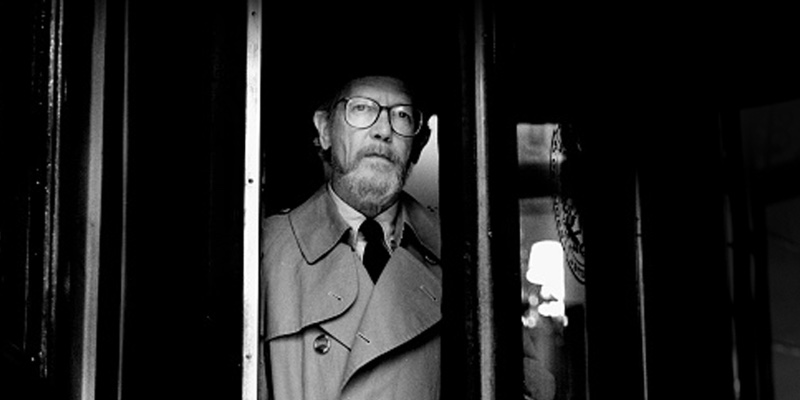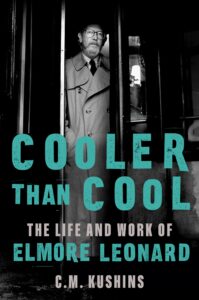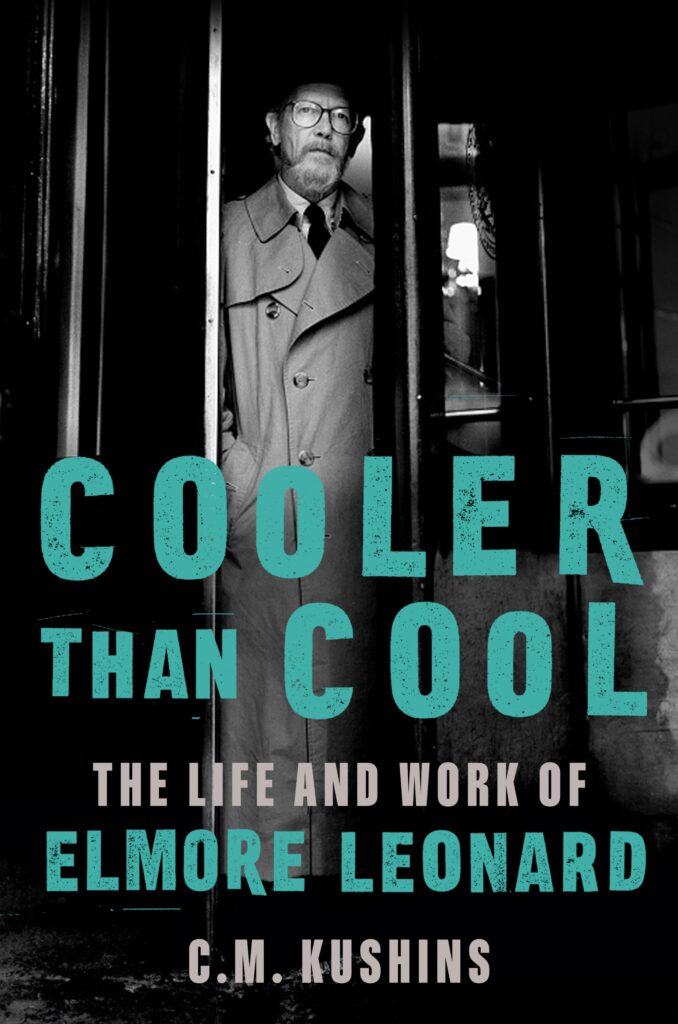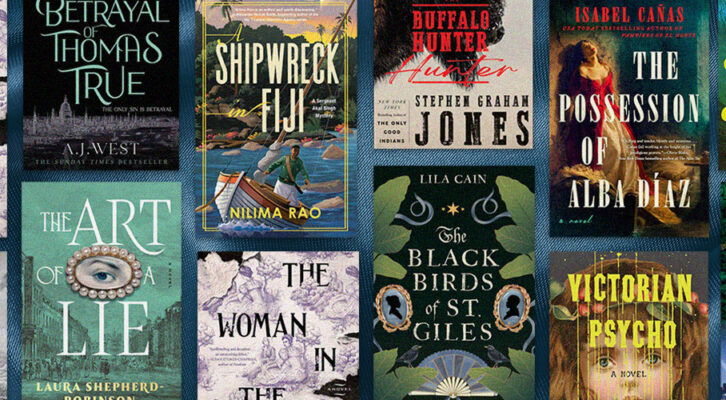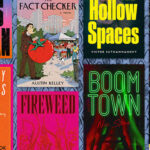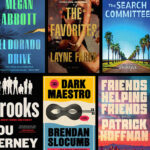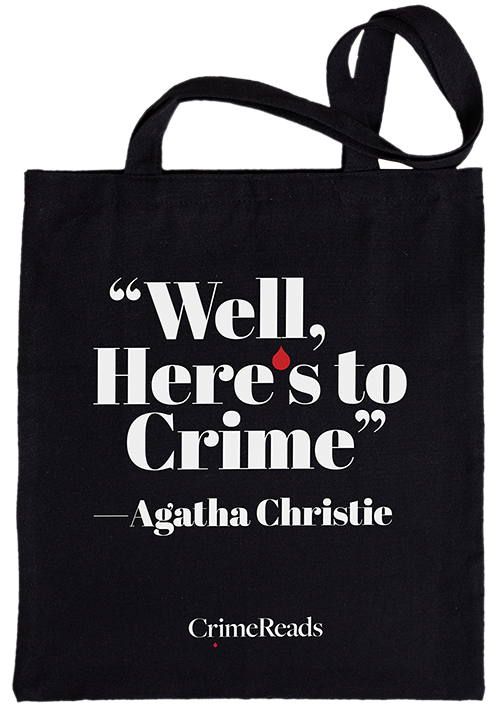Publishers have always liked my work, but were unable to sell it because it didn’t fit neatly into a category. At least, that’s what they told me. That my work was a sort of a hybrid. Not literary, but not pure thriller either . . . The publishers kept insisting that if they couldn’t label my books, or if I didn’t have a continuing character, they couldn’t sell them.
–Elmore Leonard
Leonard wrote to H. N. Swanson on February 25, “[John] Foreman, when he was here Sunday, kept expressing surprise at my office and home and the way we live. I think he expected to see Ma and Pa Kettle at the Trailer Camp. He commented with some amazement on my older daughter’s boyfriend wearing a tie. I said to him, ‘It’s Sunday, isn’t it?’ ”
It was unprecedented that Leonard would take a meeting at his home on a Sunday morning, but John Foreman wasn’t necessarily like others who often made similar requests. Foreman was the other half of Newman-Foreman Company—the production entity Paul Newman had founded just after the 1967 release of Hombre. Together, he and Newman had produced Butch Cassidy and the Sundance Kid, as well as both of Newman’s obligatory projects for First Artists, The Life and Times of Judge Roy Bean and Pocket Money. As Steve McQueen still hoped to sway First Artists into cofunding American Flag as his next project for the company (he’d ultimately committed to Sam Peckinpah’s The Getaway as the first), both Newman and Foreman were curious to hear more about Leonard’s treatment.
Hollywood assignments had already kept him from new fiction for nearly a year and a half. Since then, Leonard had devoted himself exclusively to screenwriting, considering penning a film’s companion novel—or “novelization”—only if the money was right. As a result, Leonard had little time to experiment with his fiction, to apply the lessons learned from his year and a half toiling with The Big Bounce. He expressed his growing concerns on the matter to Swanson. Leonard later recalled, “[Swanson] called to ask if I’d read a recently published novel called The Friends of Eddie Coyle. I told him I hadn’t heard of it and he said, ‘This is your kind of stuff, kiddo, run out and get it before you write another word.’”
Leonard took Swanson’s recommendation and breezed through George V. Higgins’s critically acclaimed 1970 debut in one sitting, later claiming “[I] felt as if I’d been set free, [thinking] ‘so this was how you do it.’ ” Like Leonard, Higgins was an anomaly in the publishing world. At only thirty-three, the Boston native already had a full legal career behind him, having served as deputy assistant attorney general for the Commonwealth of Massachusetts and had fought organized crime in a multitude of other, higher government positions. Higgins had also honed his writing skills through both his education and his day job: he too had learned the Socratic Method from Jesuit priests at his own alma mater, Boston College, as well as careful study of the wiretap recordings used in his criminal cases; the latter had proven that an emphasis on realistic dialogue could create gritty urban characters.
Composed of nearly 90 percent dialogue, The Friends of Eddie Coyle was directly inspired by the ruthless traffickers and killers Higgins saw (and heard) in Boston courtrooms every day—their murmured conversations obscuring true, violent intentions and cruel street politics, all under a veil of slang and vague insinuations. One could listen closely and become horrified by the hidden world of pathetic, jaded henchmen lurking beneath—a world populated by men whose survival instincts supersede morality and loyalty. In this world, there are no “friends”—a lesson brutally learned by Higgins’s unwitting protagonist, Eddie Coyle, a longtime hood so low on the mob totem pole, conspiratorial gang members and law enforcement agents alike don’t remember he exists. In Higgins’s hands, the deceptively simple, dialogue-driven story played like Greek tragedy among thieves, the tone reminiscent of Jim Thompson and dialogue inspired by Higgins’s own champion, John O’Hara. Most important, there were no good guys or bad guys in Higgins’s world, only real people who were a product of their environment and their decisions—and they could talk. Leonard took careful note. However, he was more impressed with Higgins’s technique beginning each scene with action already occurring, forcing the reader to catch up with the characters mid-conversation. Likewise, Higgins would often alternate character perspectives from scene to scene, allowing readers to decipher each one’s attitude and agenda. With those innovations in place, the author could eliminate extraneous descriptions of people and places. “What I learned from George Higgins was to relax, not be so rigid in trying to make the prose sound like writing,” Leonard later recalled, “to be more aware of the rhythms of coarse speech and the use of obscenities . . . Most of all, [to] hook the reader right away.”
Leonard was now determined to adapt some of Higgins’s devices within his own work. He just needed a new book with which to experiment.
During their February call, Swanson also presented Leonard with another tangible project to consider, an assignment from famed producer Walter Mirisch, whose decade-long string of box office hits already included three Academy Award Best Picture winners: The Apartment, West Side Story, and In the Heat of the Night. Mirisch, the youngest of three sons to a Polish immigrant father and younger mother, had initially worked his way to head of production for Allied Artists Studio—a small division of the Monogram Pictures Corporation; in 1957, he founded The Mirisch Company, then went on to bigger and better things, primarily for United Artists. He had recently purchased the film rights to Arthur Hailey’s Wheels—a history of the Detroit automobile industry presented as a decade-spanning, sweeping epic, à la James Michener’s Hawaii (another film adaptation Mirisch had already produced)—and he sought a suitable screenwriter. Aware that Leonard was a proud resident of Detroit, he had turned to Swanson, inquiring if his client would have any interest in writing the script. Leonard later recalled, “Walter thought I was right for [Wheels] since I lived in Detroit and had spent several years writing car ads. I remember asking my agent . . . ‘Do I have to read the book?’ and Swanie saying, ‘It won’t hurt you.’” Swanson urged Leonard to accept the gig, especially as his other properties remained in production limbo. Leonard responded the following day, “I’ve been thinking about Wheels . . . And when I think about it, I realize that I know more about the automobile business than anything I’ve ever written about.” Although he quickly digested Hailey’s bestseller, he later admitted, “Hailey was so wrapped up in endless character development and background that he failed to capture the essence of what the automobile industry is. It’s not about making cars; it’s about selling them.”
The first week of March, Swanson sent the full pitch for Mr. Majestyk to Mirisch, who immediately saw it as a star vehicle for Steve McQueen and convinced United Artists to pay Leonard to write the screenplay. Unbeknownst to Mirisch—or to Leonard and Swanson, for that matter— McQueen was ready to throw his hands up with American Flag. The star had just wrapped on Sam Peckinpah’s rodeo drama Junior Bonner, and he was already in Texas with Ali MacGraw to begin principal photography on The Getaway—again for Peckinpah. “Over a period of time, I tried to get Steve McQueen interested in [Mr. Majestyk], but I couldn’t get him to commit,” Mirisch recalled. Nevertheless, Leonard finished the rewrites to American Flag and prepared for a week in Grand Bahama with Beverly, bookended with visits to his mother in Pompano Beach until the first week of April. “As I mentioned on the phone, I’ll have paper and pencil with me, so no time will be lost,” he wrote Swanson. “The pages might have sand stuck to them, but that can always be brushed off. Right?”
What Leonard yet hadn’t mentioned was that he’d finally found the perfect novel with which to apply his new, post-Higgins writing technique— a novel of Mr. Majestyk.
On the surface, he hadn’t tinkered too much with the initial plot points of Joe Doran Is a Dead Man, essentially plucking its lead protagonist and cat and mouse storyline, and setting them into the world of Picket Line. A few characters made it past the transition, including Larry Mendoza, now reimagined as Majestyk’s field manager and closest friend, and Frank Renda’s moll, Wylie—although now downgraded as Majestyk’s love interest in order to make room for tough and pretty union leader Nancy Chavez. Like Picket Line, the story opened with a panorama of picking fields—now the melon crops of southern Colorado—and dozens of migrant workers lining the road, each hoping to be selected for Vincent Majestyk’s team. (Leonard reused Picket Line’s “gas station restroom” scene to introduce the enigmatic farmer, with Majestyk replacing Chito Cruz in defending a group of workers against a bigoted attendant.) Upon returning to his farm, Majestyk is soon harassed by local thug Bobby Kopas, who attempts to bully Majestyk into using his unqualified field workers to pick his crops. When the situation turns violent, Majestyk’s act of self-defense lands him in county jail. (Leonard replaced Joe Doran’s bowling alley brawl with Majestyk’s shoving Kopas down in self-defense, seamlessly overlaying his revisions nearly beat for beat on top of the original Joe Doran treatment. From there, however, the stories were nearly identical.)
“I’m happy with the story now, confident it will work, and see all kinds of possibilities for the development of nice, tight scenes,” he wrote to Swanson on April 14. “You may recognize a couple of scenes I pulled out of Picket Line (the opening and the scene in the gas station) which fit in as though they were designed for this story. I’ve always liked these scenes and was determined to use them somehow or other. Also, I think it’s time for a Polish hero. As long as he doesn’t screw up too much.”
Indeed, studying The Friends of Eddie Coyle had paid off. Leonard had successfully written new scenes told from other characters’ points of view, as well as revised a few older ones in the new style. Admittedly cautious, he offered Swanson a disclaimer: “I hope the reader realizes there will be scenes told from the point of view of Renda and Tommy Kopas. And it stands, in simplifying the story line, it’s all told from Majestyk’s point of view.” He rushed copies of the new treatment and sample chapters to Swanson that same afternoon. However, Leonard was at a slight disadvantage regarding the novel’s eventual publication. Previously, The Moonshine War had been published before the film’s release, meaning changes to the shooting script couldn’t possibly affect the hardcover novel. But Walter Mirisch had already fully committed to producing Mr. Majestyk—sharing his intention to begin principal photography the following year after completing The Spikes Gang, starring Lee Marvin. While the closed deal was excellent news, it also meant that, much like The Big Bounce before it, the film would hit theaters before the novel’s publication—rendering Mr. Majestyk the book to a mere paperback novelization.
Leonard flew to LA to meet with Mirisch on May 24, the same day the Mr. Majestyk acquisition made the front page of the Hollywood Reporter. During the afternoon meeting, Leonard took notes while Mirisch suggested revisions: Leonard lengthened the first act’s climactic capture of Frank Renda, fleshing out the killer’s desperate attempts at bribery, pleas now made reminiscent of biblical temptations and—of lasting importance to Leonard’s future portrayal of female characters—requests from the actress cast as Wylie, Frank Renda’s moll and accomplice, Lee Purcell. While in both Leonard’s shooting script and ensuing novelization, Wylie is a traditional femme fatale—even clad in a bikini while somewhat passively listening to Renda’s revenge schemes—Purcell had insisted that the character be sufficiently modernized to the social norms of the times. “[Originally] I had turned it down,” she later recalled. “I had trouble with the character. I got to the location and studied the script, I immediately thought, ‘Well, this is a very one-dimensional girl. She’s just ‘the girl’—and I had already played a lot of ‘the girls’ So, when it came time to come up with a look for Wylie, I didn’t want to do the typical cleavage-pushed-up, skirt-hiked-up cliché. I told them, ‘I want to look like my aunt, very sophisticated—hair in an elegant bun, with big hoop earrings.’ And they went for it, making the character more of a consiglieri—something more like an attorney having an affair with her client, as opposed to a damsel in it for kicks.”
The following month, Columbia Pictures officially passed on American Flag. “This is a competent commercial script by an experienced screenwriter, and therefore deserves serious consideration,” Columbia Pictures’ hired consultant wrote on July 26. “Upon serious consideration, I recommend that it be rejected.” According to the memo’s author, the screenplay contained more “liabilities than assets,” including its revenge motif and a lack of sincerity in the protagonist’s motivations, finally assessing it as “a lukewarm piece of material.” He added, “As for the notion that the two old buddies join hands to reject their old girlfriend (the only girl in their lives), we leave that to the Freudians.” (The twenty-six- year-old freelancer who had advised Columbia Pictures against Leonard’s American Flag was only two years away from selling his own first script, The Yakuza, to Sydney Pollack—and four away from writing Taxi Driver for Martin Scorsese. But future auteur Paul Schrader was also a quarter of a century away from the day he’d ask Leonard if anything among his dozens of properties was available for him to direct—and be curtly told only a single one was left.)
For now, however, Columbia Pictures’ hard pass on American Flag presented producer-star Steve McQueen with two options: abandon the film, or convince First Artists to let him shop it for another cofinancier. With Mr. Majestyk in full swing in Colorado and Joe Kidd about to hit theaters, Leonard and Swanson allowed McQueen to let it ride.
***
Universal Pictures released Joe Kidd on July 19.
Reviews were lukewarm, most citing the revenge-themed film as familiar terrain. The film’s climax—which Leonard hadn’t written—drew much of the critics’ ire. “It’s pretty much as usual in Joe Kidd,” wrote Time magazine. “[Eastwood] rights matters soon enough, even going so far as to drive a locomotive smack through some of Sinola’s newest buildings. The set seems to have been constructed solely with this event in mind, looking as it does like something plucked from the window of F.A.O. Schwarz.” Again, however, Leonard himself remained relatively unscathed. The Los Angeles Times’ Kevin Thomas wrote, “[The film] forthrightly depicts injustices to Mexican-Americans, which strikes a note of contemporary awareness without seeming to strain for relevance. At the same time, Joe Kidd, well written by Elmore Leonard, manages to be a satisfying, traditional-style adventure entertainment, set against the rugged natural beauty of New Mexico.”
Regardless of its mixed reviews, Joe Kidd was a box office hit for Warner Bros. and Clint Eastwood’s Malpaso Productions, grossing over $6 million worldwide.
Bantam officially rolled out Forty Lashes Less One in mid-October—more than two years since Leonard finished writing it. Although the publisher would surely get first-look rights toward Leonard’s new book, he knew presenting them with a movie tie-in could be problematic; movie novelizations rarely received the same critical attention as a proper novel— meaning Leonard’s follow-up to Mr. Majestyk had to be particularly strong. With that in mind, he had high hopes for his latest proper novel, tentatively entitled Backfire. Leonard packed his notes and wrote to Swanson on November 25, “In case anybody wants to give us money and you have to get in touch with me next week, I’ll be in Pompano Beach, Florida . . . we’ll be home Monday night, Dec. 4.” He added, “This, you understand, is a business trip.”
To Leonard, the final lesson learned from reading George V. Higgins’s The Friends of Eddie Coyle had been the author’s intimate use of his native Boston, adding new levels of realism and grittiness to the prose. As a proud resident of Detroit for more than thirty years, Leonard decided to use the same strategy for the new book. In that regard, the aborted assignment adapting Wheels for Walter Mirisch couldn’t have come at a better time; Detroit was already a hot topic in the national headlines due to the automobile industry and the city’s economic decline. While the previous decade had seen the nation’s crime rate double—the social breakdown associated with anti–Vietnam War student protests, the Civil Rights movement, and rampant drug use all cited as contributing factors—Detroit had been hit especially hard. Within only a few years, theft, violent assault, and ghastly gang murders had become commonplace within the urban areas of the city limits—as was the rise of heavily armed street gangs. In 1967, the city reported 281 homicides; by 1972, the number had ballooned to 672—nearly triple those of New York or Chicago. The once-thriving metropolis once known as “Motor City, USA” had become “Murder City” in the media, touting the highest crime rate in the nation, emphasized by an era of unemployment and social turbulence. Just as the Great Mi- gration had drawn so many Americans to the city a half century earlier, the mass exodus of major automakers had led to some of the country’s worst waves of unemployment; by 1970, one out of every three adults in Detroit was unemployed or on welfare. (Asked later his opinion on the causes of Detroit’s decline, Leonard was candid in his views: “The fact that 700,000 left town and moved out to the suburbs,” he told journalist Anthony May. “Oh, we still produce more cars than anybody but not to the point where we can be cocky about it.”
Having reimmersed himself in the Detroit automobile industry while adapting Wheels for Walter Mirisch, Leonard decided to incorporate his expertise into the new novel. Even his time with John DeLorean had paid off, as the iconoclast’s demeanor and world of suburban affluence on the outskirts of Detroit would work their way into the new protagonist— the owner of a moderately sized automotive parts plant. The only research required on Leonard’s behalf was some knowledge of the specific car parts themselves, some of which he was already familiar with thanks to his freelancing days. To stay up on current trends, Leonard studied the Stilson company’s full line of machine tool and material-handling factory accessories, noting the industrial jargon associated with conveyor rolls, urethane bumpers, vacuum lifters, lock clamps, and production adapters. For the book’s climax, however, Leonard researched the practical applications of dynamite and bomb defusal.
***
Leonard’s opening words rang like a starter’s pistol—“He could not get used to going to the girl’s apartment”—throwing the reader into Harry Mitchell’s world mid-scene and evoking the shadowy uneasiness to come. Entering the condominium he’d rented for his much-younger mistress for one of their regular trysts, middle-aged auto-parts executive Mitchell is, instead, ambushed by three gun-wielding masked assailants who force him to watch home movies of his extramarital activities. What’s worse, the trio appear to know everything about Mitchell—including intricate details of his financial holdings and investments—and propose an exchange of $105,000 for the telltale film. But rather than yield to the extortionists’ demands, Mitchell comes clean to his wife, Barbara, and initiates a manipulative counterscheme to turn the tables on his aggressors. A brutal game of cat and mouse begins, with Mitchell discovering the identities of his blackmailers and planting seeds of deceit among their organization, ultimately weakening their resolve and trust.
Leonard approached the novel with a newly liberated sense of the contemporary, featuring an all-too-human antihero in Mitchell, and three particularly psychopathic blackmailers: Leo Frank, the owner of a strip club where Mitchell’s young girlfriend, Cini, had worked; armed robber and killer-for-hire Bobby Shy; and the mastermind, accountant turned pornographer and rapist Alan Raimy. When Mitchell is slow paying up, the trio brutally retaliates by killing Cini with Mitchell’s own gun, then forcing him to watch a snuff film of the killing. Although he could now be framed for the girl’s murder, Mitchell continues to ignore pleas from Barbara and his attorney to notify the police. Rather, he negotiates the extortion amount down to fifty-two thousand dollars, buying more time to plan his brutal counterattack.
In an effort to separate the novel from any potential adaptation, Leonard considered giving each version its own title. For the book version, he’d tentatively chosen Backfire—a reference to the would-be blackmailers’ unsuccessful plan; for the film treatment, he chose the extorted prize of $52,000 itself, coolly abbreviated as Fifty-Two Pickup. “At the time, I didn’t realize it,” Leonard later recalled, “but now I see that was the beginning of the voice that I’ve developed . . . I realized how much fun I could have with those people, that I don’t have to make them entirely de- spicable. I can have fun with the guys who are into crime—into the life.” On February 12, 1973, he wrote to Swanson, “I’ll have to do some more thinking about a title. The latest idea, Backfire, has lost what little appeal it had last week. The book should go another two-hundred pages, or about seventy-thousand words.” Leonard put his outline aside and launched into the first draft, nearly completing in just under two months.
In June, Swanson closed a deal with Delacorte for the newly retitled Fifty-Two Pickup: ten thousand dollars—half upon signing, then the following installments upon delivery and publication. Leonard was soon introduced to Jackie Farber, the new senior editor at Dell with whom he would be collaborating on his unofficial contemporary re-debut. Farber later recalled that editing Leonard was particularly easy, and that the author would always take her editorial suggestions “very well.” If there had been any trepidations on his part regarding a further leap into the contemporary crime genre, she claimed, “it never showed.” Farber had already discussed the manuscript with publisher Ross Claiborne— then working with Leonard on the Mr. Majestyk novel—who agreed that story worked well up until the final act. “After that it races forward, each step falling too neatly into place,” she wrote Leonard. “You said you had worked hard on the economy of the prose style, [but] I think you can still fill in with information and keep the style pretty spare.” Farber also insisted that Leonard leave Harry “in the dark” for a longer duration of the narrative, claiming, “Even Sam Spade went up a few wrong alleys.
Leonard received the galley proofs for Fifty-Two Pickup on September 2, quickly scanning Farber’s final continuity questions and signing off on the completed manuscript. Farber wrote back four days later. Swan- son had moved on the property just as quickly. The second week of September, Philip Barry, a producer for Tomorrow Entertainment, contacted Leonard directly, expressing his interest to adapt Fifty-Two Pickup once the ongoing writers’ strike came to an end and assuring him, “Your man Mitchell is exactly the kind of hero the movie audience is looking for today.”
Leonard had used the time allotted by the strike to complete the novel of Mr. Majestyk—a smart loophole for which Swanson, well-versed in the finer print of union protocols, was able to keep his author clients’ hands busy. Now, at Barry’s request, Leonard agreed to fly out to Los Angeles on September 22 to meet with the young producer and his project partner, Roger Gimbel. All three were left satisfied with the shared vision of a Fifty-Two Pickup film. However, in making the leap from page to screen, both Barry and Gimbel insisted that certain scenes would need to be tweaked for the screen, noting that the source material had been “loaded with dialogue.” More directly, Barry insisted Leonard “look for every opportunity to play out scenes in a filmic sense with a minimum of dialogue,” unaware that an emphasis on dialogue was the key tenet of Leonard’s new literary voice. He was now tasked with pruning through his most mature novel to date for scenes that could be tossed into the fire, many of which leaned on gritty dialogue for the book’s rich characterization. Leonard soon admitted to the producer, “It’s funny how you can think you have planned a book to develop in film sequences, making the adaptation easy, or at least easier. But it isn’t there until you actually think of it as a picture.” Running with their agreed-upon changes, Leonard delivered his first draft to Barry the second week of November.
While on the Spanish set of The Spikes Gang with director Richard Fleischer, Walter Mirisch continued to brainstorm the perfect replace- ment for Steve McQueen in Mr. Majestyk. It soon dawned on him that on-screen tough guy Charles Bronson was on a career upswing, having recently followed Clint Eastwood’s example of starring in a number of European action films, elevating him from supporting player to leading man. “It had been many years since I had worked with Charlie Bronson,” Mirisch later wrote, recalling their previous collaborations on The Magnificent Seven, The Great Escape, and Kid Galahad. “I called Paul Kohner, who represented [Bronson], and I told him that I thought Mr. Majestyk would be an excellent vehicle for his client, hoping that he and Charlie would agree.” The producer even hopped a flight to Los Angeles to solidify funding and further sweeten Charles Bronson’s deal, closing on a $2 million budget—$400,000 of which would go to Bronson against 10 percent of the gross. Unfortunately, the actor had already committed to star in an adaptation of Brian Garfield’s vigilante thriller, Death Wish, the following year. In order to star as Vincent Majestyk, as Mirisch recalled, “[Bronson] needed to start shooting in September, which gave us only a short time for preparation.” Although it took some convincing, Mirisch was able to retain most of The Spikes Gang’s principal players for the next project, including director Richard Fleischer. “[Fleischer] was coming to the end of a long, difficult shoot, and he wasn’t very enthusias- tic about undertaking a second film immediately after the first,” Mirisch later recalled. “Despite his misgivings, Dick agreed to go along with this plan and segue immediately from one film to the next.” Mirisch then dispatched production manager Jim Henderling to scout locations for Mr. Majestyk’s melon fields and action sequences. “The watermelons worked out well for us,” Mirisch recalled, “because they were more photogenic and certainly a lot more dramatic when bullets were fired into them.”
Leonard had all the needed corrections for the Mr. Majestyk novel completed by the first week of October and had his secretary, Janet Smart, send off the final proofs to William Grose at Dell. Less than a week later, Grose replied, “You’re right, you’ve got much more in the novel than there is in the screenplay. It’s very good. Tight, compelling, and the characters are wonderful. Money is on its way to Swanson. Let me know what else is coming out of your typewriter.” And after months of back-and-forth regarding American Flag, Swanson finally heard from Pat Kelly at First Artists the first week of December. According to the pro- ducer, Steve McQueen’s Solar Productions had run into “an unavoidable snag in making a deal with [another] screenwriter”—an issue that could have been avoided by retaining Leonard from the beginning. As far as Leonard and Swanson’s end of the deal, Solar–First Artists still had eight months to make good on acquiring any leftover rights from their original 1971 agreement. However, this removed Swanson’s option to keep hold of Leonard’s rights to the property during that time—a potentially minor inconvenience, as all signs pointed to the start of the film’s production earlier the following year. If anything, the very fact that McQueen had circled back to the property after two years indicated he still wanted the film made—although the standstill of production hell would continue well into the new year. Fifty-Two Pickup was released by Delacorte in April 1974.
***
Although Leonard’s hopes had been high in 1970 for Doubleday’s hardcover release of The Moonshine War, and those reviews had been strong, the lukewarm reception that the ensuing film version received had seemed to have an adverse effect on the original novel. But this would not be the case with Fifty-Two Pickup—already regarded by its author, its editors, and, apparently, many critics as Leonard’s true entry into the world of contemporary crime fiction.
“For a tough American piece of writing, Fifty-Two Pickup by Elmore Leonard is recommended,” wrote the New York Times critic Harold Schonberg under his frequent nom de plume “Newgate Callendar.” “Leonard manages to get into his characters and build a believable situation. The dialogue reads in a natural manner, and is certainly tough enough, yet there is an agreeable avoidance of four-letter words, proving that profanity and toughness do not necessarily have to go together.” (Leonard himself later remarked, “The main thing I set out to do is tell the point of view of the antagonist as much as the good guy. And that’s the big difference between the way I write and the way most mysteries are written. The problem with most mysteries is the most interesting part of the stories [the crimes] are off-stage. It’s done before or while you’re not looking.”
Leonard was delighted by Swanson’s response, especially as it had been the agent who’d intentionally recommended The Friends of Eddie Coyle in order to provoke such creative inspiration. Swanson himself later told Rolling Stone, “I can’t mold a writer. I didn’t tell Faulkner what to write, or Hemingway, or James M. Cain what to write. A writer is like a cook. He puts some ingredients on the stove, lets it simmer, takes it off. I think it took Dutch a while to figure out the proper mix of ingredients.”
***
In the summer of 1974 a friend advised me to stop drinking and start going to AA meetings . . .
I thought I had to drink to relax and have a good time. Or I was self-conscious with people I didn’t know well or who didn’t drink. At my first AA meeting, I asked one of the regulars, “Aren’t parties boring if you’re not drinking?” He said, “If you think you’re gonna be bored, why go?” Straight talk. If you have a drinking problem, quit. The program will help you develop a new attitude about it.
–Elmore Leonard
With numerous deadlines met, Leonard unceremoniously planned a road trip to California and back—alone. It was the first and only time he had taken such a trip by himself, and not under the guise of vacation or to meet with Swanson or other film executives. With Mr. Majestyk ready to hit theaters in only a few weeks and Fifty-Two Pickup selling well amid glowing reviews, Leonard was finally taking the time to address much more pressing issues that had been building at home—his alcoholism and the effects it had played in the slow erosion of his marriage to Beverly.
Rather than a straight shot to Los Angeles, Leonard planned a longer, meandering itinerary, heading southwest first, then north up through Southern California counterclockwise back to Detroit. He left on July 2 at six fifteen in the morning, bringing along two weeks’ worth of casual attire and a small forty-sheet spiral travel journal, scrawling “L.A. Trip by Car” across its cover. By way of Indianapolis, he reached St. Louis, Missouri, by midafternoon, jotting down the colors of various police cars and selections from regional radio stations along the ride. He noted gui- tarist Jerry Reed’s apparent nickname, “the Alabama Wildman,” adding the first leg of the drive had already cost “eighty bucks,” then made it to Amarillo, Texas, by late the following night.
On the road, Leonard continued his random thoughts:
I love New Mexico. Clean and stark and hard. Think of movies, writing, paintings. That principle. The Midwest has a Protestant look. It closes you in. The west makes you want to go. New Mexico is scrub, but it’s good—the sky is better. In New Mexico the sky doesn’t go down, like it does in Oklahoma. It goes up. Hank Williams—“I’ll Think of Something.”
For the first time, Leonard spent July 4 on his own—no barbeque or “Elmore burgers” for the family and their children’s friends. He stayed at the Whiting Brothers Motor Lodge in Holbrook, Arizona, noting that the one good thing he could say about the motel’s accommodation was the strong water pressure: “It takes the plastic glass right out of your hand.”
Leonard soon sparked a lively conversation about music with a hitchhiker he’d picked up just outside Needles named Joe Bravo. At a roadside diner together, Leonard was amused by a brief exchange between Bravo and the waitress: “What do you do in Barstow for fun?” Bravo had asked, to which she’d quickly offered, “You get out of town.” Taking his cue, Leonard did just that, and arrived at the Sunset Marquis on July 6. He drove to Las Vegas, finally noting, “I’m getting out of here,” but added later, “I lied. Cruised the strip for one more look. But it hadn’t changed.” Leonard continued to Los Angeles the following morning, stopping roadside in Cedar City, Utah, at five o’clock to write, “Sky beginning to lighten. Looked forward to a big sunrise coming up over the Rockies, but it’s been raining. One thing, the lightning was a lot more impressive than the lights of Las Vegas.”
Ultimately, Leonard stayed in Los Angeles for a week and a half before heading home, not in a particular rush this time. He knew the inevitability that awaited him when he returned: a promise he had made to himself to attend his first Alcoholics Anonymous meeting.
“I was beginning to disguise my drinks,” Leonard later wrote. “I would drink a big Whiskey Collins instead of my favorite, which was Early Times over shaved ice. Twice I was arrested for drunk driving. That was toward the very, very end. Once in Malibu, when I was driving too slow at 2:30 a.m., then a year later in Michigan. I drank for thirty years and nothing ever happened and suddenly, two driving-while-under-the-influence arrests in a year. That’s got to tell you something.”
When Leonard was released the following morning of his second arrest, he had something to tell the officers at the Birmingham jail, as well. Of the eggs he’d been fed at breakfast, he’d advised them, “You know, it’s just as easy to cook it right.” After a profile ran in the Detroit Free Press wherein reporter Ellen Goodman had alluded to Leonard’s apparent intoxication (the one and only such incident), he was inspired to do two things: write a letter to Goodman asking for an apology (which he got), and then to calm himself and reassess his own behavior. “I tried to hide my drinking from myself,” he later admitted. “I would sit in my office— actually I had three offices. I had a refrigerator in the front office and in the middle office there was a kind of lounge. I had a bottle of sherry and little glasses there on the table. I would go in there and have a little glass of sherry from the decanter, then I’d have another one. After that, I’d get out the bottle and fill up the decanter where it had been in case anyone noticed.” Leonard continued, “Then I’d get a cold bottle of white wine out of the refrigerator and put it in my desk drawer. I’d open the drawer very, very quietly, though no one was in the office, and take the wine out and drink a big, big swig of it and put it back in. Not a soul was near enough to hear anything. I didn’t want to hear it.”
Before the summer, a number of close friends had recommended he attend an AA meeting just to get the feel of it and, perhaps, to see if he could relate to some of the other attendees’ personal stories. “All I had to do was sit at one meeting and listen to the stories to know that I was an alcoholic,” he later recalled. “I admitted it at my first meeting. I opened my mouth and it came to me, ‘I’m Dutch, and I’m an alcoholic.’”
I was forty-nine and had been a fairly serious drinker since high school. In the 1950s, martinis and Manhattans were served at cocktail parties and I was happy to go either way . . . Jack Daniels was okay, Wild Turkey was a special treat. There was always a full bottle of wine with dinner, Gallo Hearty Burgundy, ninety-seven cents. After coming home smashed from a party, my wife at the time was likely to say, “Your problem is you don’t count your drinks.” And my smartass reply would be, “Yes, I do, I had fifteen.”
I began going to meetings in ’74, would maintain my sobriety for a few months, fly off to some foreign land and fall off the wagon. No, jump off: once in Morocco, twice in Israel, several times on the West Coast, undetected.
That same month, after nearly a quarter century of marriage, Leonard and Beverly separated. He found an apartment in downtown Birmingham at 609 Merrillwood Apartments, 225 East Merrill Street. “We always drank,” he later recalled. “We always drank together. Every single night, we would get into arguments, with me drunk and her part of the way, with me saying vicious things, which I couldn’t believe the next day. I was filled with remorse.” He added, “I wonder if the booze gave me the courage to leave home, to leave the situation I was in, having been married for twenty-six years. Now that I know what I know, I’m sure I would have done it in the right way with a clear head. But I did it drinking and got away with it.”
At his very first AA meeting, Leonard was also given a number of reference materials for the long road to sobriety that lay ahead. He collected a brochure of important meeting locations and contact information, a book of the “12 Steps,” another book of more Michigan locations, and emergency contacts. Most important, Leonard received a miniature book of affirmations—much like the small leather Catholic prayer book he’d received as a child for his First Holy Communion—providing a daily read- ing for each day of the year. It was entitled Twenty-Four Hours a Day and was intended to help members in “living one day at a time” through proactive mindfulness, meditation, and prayer. The book’s foreword reminded readers, “If we don’t take that first drink today, we’ll never take it, because it’s always today.”
A Sanskrit proverb followed:
For yesterday is but a dream And tomorrow is only a vision.
But today, well lived, makes every yesterday a dream of happiness. And every tomorrow a vision of hope.
Look well, therefore, to this day.
Although Leonard didn’t begin using the book until his return from his extended July road trip, had he looked through those dates during his excursion, he might have found comfort in those missed affirmations. As he had crisscrossed the American West contemplating the next stage of his life—jotting down notes about the colors of interstate police cars, discussing jazz with hitchhikers with unusual names, and attending rodeo shows while venting about broken ice machines in roadside hotels—many of the answers he sought could have been found within the pages of his newly acquired little AA book.
His daily prayer for July 7 said it all:
Painful as the present time may be, you will one day see the reason for it. You will see that it was not only testing, but also a preparation for the life-work you are to do
***.
Mr. Majestyk held its LA premiere on July 17—the final day of Leonard’s solo road trip.
The film received mixed reviews from critics, but was a hit during its opening weekend. Vincent Canby of the New York Times called the film “mindlessly violent” and criticized Bronson’s acting, saying that “he goes through the motions of being an action hero without actually conveying any emotion or depth.” Canby also criticized the film’s script, saying that it “has no center, no originality, and no reason for being except to exploit the increasingly profitable genre of the action film.” Variety’s review was more positive, calling the film “a hard, fast action flick that never pauses for breath.” Ultimately, the film was a modest success, overshadowed by Bronson’s next feature film, which opened only a few weeks later— Death Wish. Leonard later admitted he would continue to get residuals for Mr. Majestyk for decades: “Walter [Mirisch] gave me a big bonus the moment the picture was in the black.” He added that anytime the movie would air on Japanese television, he could look forward to a check for a few hundred dollars. And although he never got the opportunity to thank Charles Bronson in person for his contribution to the project’s success, in later years, Leonard liked to recount a brush he had with the star not long after Mr. Majestyk’s production. While riding in the same elevator as Bronson at the Ritz-Carlton in Boston, he overheard the excitement the lift operator had at seeing the actor in person. “Charles Bronson! What are you doing here?” To Leonard’s amusement, the actor had replied, “I’m checking up on elevator operators.”
As hard as Leonard had been working equally on his fiction and screen- writing credits, as the decade built toward its midpoint, he slowly began to see more success on the literary front than the Hollywood scene— although the latter continued to pay handsomely, regardless of the likelihood many projects wouldn’t be filmed. Producer Walter Mirisch had taken Leonard’s draft of Wheels and passed it on to another screen- writer.28
Likewise, Leonard’s hopes of seeing American Flag produced with Steve McQueen in the lead were dashed in the coming year. Although half a decade had passed, Steve McQueen had retained his interest in Leonard’s script—although the later revisions bore little resemblance to the initial treatment that had piqued the actor’s interest in spring 1970. Soon, while compiling notes for the next novel, Leonard saw the latest revisions by McQueen’s own writing team. The final treatment did away with character names entirely, calling McQueen and wife/costar Ali MacGraw by their proper names. With the mandated action scenes and final standoff in place, Leonard made no additions to the last draft owned by McQueen’s company. When McQueen’s partners at First Artists de- cided against the film, he opted to shoot Junior Bonner for director Sam Peckinpah instead.29 Following a few more films, Steve McQueen would take a nearly five-year hiatus, returning for only two more films before his untimely death in 1980 at the age of fifty.
Around the same time, Leonard also received one of the most promising pieces of fan mail he’d ever received: “While in Detroit, I had a talk with [producer] Ken Barnard,” actor Kirk Douglas wrote from his Beverly Hills home. “We have one thing in common—we are both fans of Dutch Leonard.” The actor enthusiastically inquired if Leonard would consider doing a revision—which he felt Leonard “could do beautifully”—on the actor-producer’s upcoming Western. Leonard responded with interest immediately, initiating a correspondence between the two. He quickly set to work typing up a few ideas for Douglas’s script for Posse when it soon arrived in the mail. “My main objection to the storyline is that the five possemen to be the focal point of the story, the main characters in the third act, without a great deal of character development before that,” Leonard wrote to Douglas, then filming in London. “But the story, in its development, does not point to this conclusion. It points to a clash between the two pros, two strong-willed individuals who know their business. But this doesn’t take place. Instead, 120 minutes of action and character development lead us only to a trick ending.” In total, Leonard had sent off over a dozen pages of suggestions and intricate structural changes he felt would make the film more cohesive—and all for free. He soon followed up with Swanson, writing, “I’m not worried about him stealing it, giving the ideas to the original writer. At least it never occurred to me that he might do such a thing. I spent maybe three days on it when I wasn’t doing anything else, anyway.” (Although Leonard hadn’t planned on writing another Western in the foreseeable future, he saved the unused elements from his Posse suggestions for future use.)
When early deals with Tomorrow Entertainment for an adaptation of Fifty-Two Pickup fell through that November, Swanson immediately set to work negotiating with Israeli producer Menahem Golan to pur- chase the property; Golan was interested in the story, but insisted that the script be rewritten with Tel Aviv as the setting. Before the year was out, Leonard agreed to fly to Tel Aviv and tackle the “Israeli Fifty-Two Pickup”—but first, he had to put the finishing touches on Bud and Stick, Inc.—soon to be retitled Swag.

